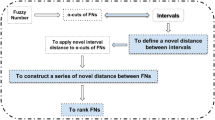Abstract
A variety of methods for ranking fuzzy sets has been suggested. Generally, these methods fall under two main categories: a fuzzy-real sets mapping, a dominance relation of one fuzzy set over another. The original approach proposed in this paper belongs to the second category, as the ranking is based on the degree of inclusion in the MIN of two fuzzy numbers. The novelty lies mainly in the intuitive connection between the topological relationship of fuzzy shapes (triangles, trapezoids, etc.) and the measure of inclusion or dominance referred as inclusion index. This connection led to the classification of different topological relationships into classes identified by a binary pattern. This operation is referred to as Bitset Encoding. Consequently, the outcome of a ranking is already decided for most cases by merely identifying its pattern. Ultimately, the method is validated by the axiomatic system of Wang and Kerre and proven to be a reliable, efficient and strong potential alternative to the other prominent methods.












Similar content being viewed by others
References
Abbasbandy, S., & Asady, B. (2006). Ranking of fuzzy numbers by sign distance. Information Sciences, 176(16), 2405–2416.
Abbasbandy, S., & Hajjari, T. (2009). A new approach for ranking of trapezoidal fuzzy numbers. Computers & Mathematics with Applications, 57(3), 413–419.
Adamo, J. (1980). Fuzzy decision trees. Fuzzy Sets and Systems, 4(3), 207–219.
Asady, B., & Zendehnam, A. (2007). Ranking fuzzy numbers by distance minimization. Applied Mathematical Modelling, 31(11), 2589–2598.
Bordogna, G., Bosc, P., & Pasi, G. (1996). Fuzzy inclusion in database and information retrieval query interpretation. In Proceedings of the 1996 ACM symposium on applied computing (pp. 547–551). ACM
Boukezzoula, R., Galichet, S., & Foulloy, L. (2007). Min and max operators for fuzzy intervals and their potential use in aggregation operators. IEEE Transactions on Fuzzy Systems, 15(6), 1135–1144.
Boulmakoul, A. (2006). Fuzzy graphs modelling for hazmat telegeomonitoring. European Journal of Operational Research, 175(3), 1514–1525.
Chen, S. (1985). Ranking fuzzy numbers with maximizing set and minimizing set. Fuzzy Sets and Systems, 17(2), 113–129.
Cheng, C. (1998). A new approach for ranking fuzzy numbers by distance method. Fuzzy Sets and Systems, 95(3), 307–317.
Cheng, C. (1999). Evaluating weapon systems using ranking fuzzy numbers. Fuzzy Sets and Systems, 107(1), 25–35.
Chiu, C., & Wang, W. (2002). A simple computation of min and max operations for fuzzy numbers. Fuzzy Sets and Systems, 126(2), 273–276.
Choobineh, F., & Li, H. (1993). An index for ordering fuzzy numbers. Fuzzy Sets and Systems, 54(3), 287–294.
Chou, S., Dat, L., & Yu, V. (2011). A revised method for ranking fuzzy numbers using maximizing set and minimizing set. Computers & Industrial Engineering, 61(4), 1342–1348.
Chu, T., & Tsao, C. (2002). Ranking fuzzy numbers with an area between the centroid point and original point. Computers & Mathematics with Applications, 43(1), 111–117.
Detyniecki, M., & Ronald, R. (2000). Ranking fuzzy numbers using \(\alpha \)-weighted valuations. International Journal of Uncertainty, Fuzziness and Knowledge-Based Systems, 8(05), 573–591.
Dubois, D., & Prade, H. (1978). Operations on fuzzy numbers. International Journal of Systems Science, 9(6), 613–626.
Ezzati, R., Allahviranloo, T., Khezerloo, S., & Khezerloo, M. (2012). An approach for ranking of fuzzy numbers. Expert Systems with Applications, 39(1), 690–695.
Facchinetti, G. (2002). Ranking functions induced by weighted average of fuzzy numbers. Fuzzy Optimization and Decision Making, 1(3), 313–327. doi:10.1023/A:1019692914431.
Klir, G., & Yuan, B. (1995). Fuzzy sets and fuzzy logic: Theory and applications. New Jersey: Prentice Hall.
Kóczy, L., & Hirota, K. (1993). Approximate reasoning by linear rule interpolation and general approximation. International Journal of Approximate Reasoning, 9(3), 197–225.
Laarabi, M. H., Boulmakoul, A., Mabrouk, A., Sacile, R., & Garbolino, E. (2014). Real-timefastest path algorithm using bidirectional point-to-point search on a fuzzy time-dependent transportation network. In 2014 international conference on advanced logistics and transport (ICALT) (pp. 78–84). IEEE
Wang, X., & Kerre, E. (2001). Reasonable properties for the ordering of fuzzy quantities (i). Fuzzy Sets and Systems, 118(3), 375–385.
Wang, Y. (2009). Centroid defuzzification and the maximizing set and minimizing set ranking based on alpha level sets. Computers & Industrial Engineering, 57(1), 228–236.
Yao, J., & Wu, K. (2000). Ranking fuzzy numbers based on decomposition principle and signed distance. Fuzzy Sets and Systems, 116(2), 275–288.
Zhang, X., & Xu, Z. (2012). A new method for ranking intuitionistic fuzzy values and its application in multi-attribute decision making. Fuzzy Optimization and Decision Making, 11(2), 135–146. doi:10.1007/s10700-012-9118-9.
Author information
Authors and Affiliations
Corresponding author
Appendices
Appendix 1: Encoding procedure

Appendix 2: Compare procedure

Rights and permissions
About this article
Cite this article
Boulmakoul, A., Laarabi, M.H., Sacile, R. et al. An original approach to ranking fuzzy numbers by inclusion index and Bitset Encoding. Fuzzy Optim Decis Making 16, 23–49 (2017). https://doi.org/10.1007/s10700-016-9237-9
Published:
Issue Date:
DOI: https://doi.org/10.1007/s10700-016-9237-9




